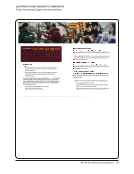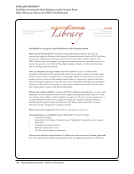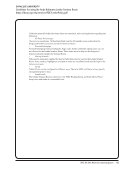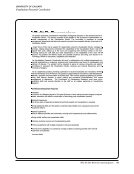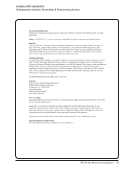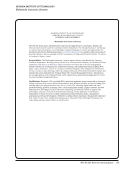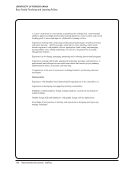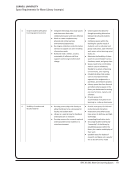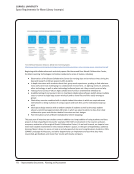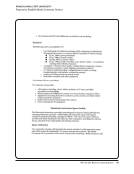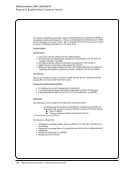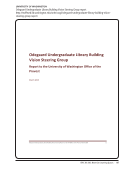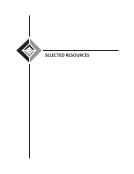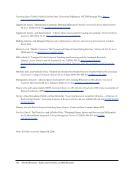SPEC Kit 342: Next-Gen Learning Spaces · 11
EXECUTIVE SUMMARY
Introduction
Our research focuses on how libraries today are uti-
lizing their learning spaces and what activities define
these spaces. By looking at the evolution and develop-
ment of library learning spaces over time, we hope
to identify important trends within libraries that are
acting as catalysts for civic and academic engage-
ment. This survey looks at current and future trends
in Next-Gen library learning spaces and then breaks
this general concept down further into the instruction,
programming, and collaborative endeavors within
these spaces and ultimately, the means of assessment
for these spaces. This survey was distributed to the
125 ARL member libraries in April 2014. Seventy-two
libraries (58%) responded by the May 14 deadline. The
survey findings reflect how academic libraries are
adapting to the changing educational landscape and
where libraries fit within the academic ecosystem.
Current Climate and Trends
Based on the survey data, dedicated learning spaces
within research libraries can range from 5% of the
total library square footage to nearly 80%. With the
average learning space footprint in the responding
libraries close to 30% of total library space, it’s no won-
der they are constantly rethinking how these spaces
should be utilized, managed, promoted, and assessed.
Space for physical collections is on the decline and is
being replaced with studios, labs, innovative class-
rooms, serendipitous communities, and interactive
scholarly environments through which librarians are
finding opportunities to contribute in new ways to
higher education.
Trends in the findings from the 72 responding
institutions indicate learning spaces in libraries are
evolving from open and self-directed spaces to guid-
ed spaces. This is not to say all space for independent
study is being eliminated, but survey data indicates
the way libraries program learning spaces is being
restructured to guide users through the learning life
cycle from start to finish.
Types of Learning Spaces
Over 88% of respondents reported the current use
of events space, exhibit space, classrooms with fixed
stations, and various open study spaces within their
libraries. These more commonly used spaces are now
making way for new, tailored labs and specialized
educational environments. Some of the newer, yet less
common, learning spaces now in use are visualiza-
tion labs (9 responses, or 13%), makerspaces (13%), fac-
ulty commons (8, or 11%), gaming labs (6, or 8%), and
hackerspaces (1%). These spaces often foster external
collaborations with community and campus entities,
inviting the creation of new labs, centers, instruction,
programs, or events. For example, visualization labs
simultaneously act as an educational tool and a show-
case for academic research and student work, thus be-
coming a Next-Gen exhibit hall. Makerspaces can give
all students, regardless of academic discipline or focus,
the opportunity to work in an area such as a tech-
nology sandbox, a creative artistic studio, or a tactile
learning environment. Additionally, tailored learning
spaces often give libraries a way to address accessibil-
ity and special needs issues. In all of these learning
spaces and examples, librarians have the opportunity
to interact with users through much of the learning life
cycle while contributing specialized expertise.
All but one of the respondents stated that the phys-
ical configuration of their library has changed over
EXECUTIVE SUMMARY
Introduction
Our research focuses on how libraries today are uti-
lizing their learning spaces and what activities define
these spaces. By looking at the evolution and develop-
ment of library learning spaces over time, we hope
to identify important trends within libraries that are
acting as catalysts for civic and academic engage-
ment. This survey looks at current and future trends
in Next-Gen library learning spaces and then breaks
this general concept down further into the instruction,
programming, and collaborative endeavors within
these spaces and ultimately, the means of assessment
for these spaces. This survey was distributed to the
125 ARL member libraries in April 2014. Seventy-two
libraries (58%) responded by the May 14 deadline. The
survey findings reflect how academic libraries are
adapting to the changing educational landscape and
where libraries fit within the academic ecosystem.
Current Climate and Trends
Based on the survey data, dedicated learning spaces
within research libraries can range from 5% of the
total library square footage to nearly 80%. With the
average learning space footprint in the responding
libraries close to 30% of total library space, it’s no won-
der they are constantly rethinking how these spaces
should be utilized, managed, promoted, and assessed.
Space for physical collections is on the decline and is
being replaced with studios, labs, innovative class-
rooms, serendipitous communities, and interactive
scholarly environments through which librarians are
finding opportunities to contribute in new ways to
higher education.
Trends in the findings from the 72 responding
institutions indicate learning spaces in libraries are
evolving from open and self-directed spaces to guid-
ed spaces. This is not to say all space for independent
study is being eliminated, but survey data indicates
the way libraries program learning spaces is being
restructured to guide users through the learning life
cycle from start to finish.
Types of Learning Spaces
Over 88% of respondents reported the current use
of events space, exhibit space, classrooms with fixed
stations, and various open study spaces within their
libraries. These more commonly used spaces are now
making way for new, tailored labs and specialized
educational environments. Some of the newer, yet less
common, learning spaces now in use are visualiza-
tion labs (9 responses, or 13%), makerspaces (13%), fac-
ulty commons (8, or 11%), gaming labs (6, or 8%), and
hackerspaces (1%). These spaces often foster external
collaborations with community and campus entities,
inviting the creation of new labs, centers, instruction,
programs, or events. For example, visualization labs
simultaneously act as an educational tool and a show-
case for academic research and student work, thus be-
coming a Next-Gen exhibit hall. Makerspaces can give
all students, regardless of academic discipline or focus,
the opportunity to work in an area such as a tech-
nology sandbox, a creative artistic studio, or a tactile
learning environment. Additionally, tailored learning
spaces often give libraries a way to address accessibil-
ity and special needs issues. In all of these learning
spaces and examples, librarians have the opportunity
to interact with users through much of the learning life
cycle while contributing specialized expertise.
All but one of the respondents stated that the phys-
ical configuration of their library has changed over









































































































































